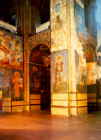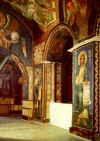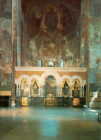St. Cyril's Church was built
near Dorogozhichi in the environs of ancient Kyiv in the mid - twelfth
century. It was from here that Prince Vsevolod Olgovich of Chernigov sent
his warriors to seize the city, and, in 1139, in the course of internecine
wars, he won and mounted the Grand Throne of Kyiv. The church served as
an out-of-town residence and the burial place for the Olgovichi princes.
In 1194, Kyivan Prince Svyatoslav, a hero of the Old Rus epic The Lay of
lgor's Host, was interred here.
Throughout its existence,
St. Cyril's Church has undergone periods of deterioration, and several
times the structure has been repaired and modified architecturally. From
1748— 1760, stone monastery buildings were erected near the church under
the supervision of Ukrainian architect Ivan Hrihorovich-Barsky. Only a
section of the wall with a corner tower has survived of them from the eighteenth
century into modern times. As a result of the alterations and reconstructions
carried out in the seventeenth and eighteenth centuries, the ancient St.
Cyril's Church was given its present-day architectural form obviously dominated
by Ukrainian Baroque.
In the 1860s, twelfth-century
fresco paintings were discovered on the walls under the eight-eenth century
plaster, and in 1881—1884 extensive work to restore the murals was carried
out under the supervision of Professor A. Prakhov. Engaged in the restoration
were teachers and students of the Drawing School of Kyiv, among them N.
Murashko, 1. Seieznyov, N. Pimonenko, Kh. Platonov, 1. Izhakevich, S. Haiduk,
F. Zozulin, to mention but a few. In 1884, the eminent Russian painter
Mikhail Vrubel took part in the restoration works. At the request of the
church authorities, the ancient frescoes were re-painted in oil by Vrubel.
During the same period, choir parapets of marble and an iconostasis designed
by Prakhov were installed in the church.
In May 1929, St. Cyril's
Church was proclaimed a museum. Extensive research was begun there which,
unfortunately, was halted by the outbreak of World War Two. In the post-war
period, work was carried out to reinforce the walls and foundation which
had been deformed as a result of damage done by an ancient underground
passage. Later, the restoration in the church was recommenced, and the
museum was opened to the gen-eral public.
The twelfth-century architecture
of St. Cyril's Church has survived into our times with scarce-ly any alterations.
The renovations in the seventeenth and eighteenth centuries consisted mainly
of rebuilding a few sections of the vaults, the addition of four lateral
domes, a lavishly decorated pediment, and decorative window and door surrounds.
The ancient architectural forms are easily discernible in spite of these
later modifications. This single-domed church was designed as a three-aisled
and six-piered structure with three apses running from west to east. Its
dimensions were 31 x 18.4 meters, and the ceiling was 28 meters high. The
blind arcading has not been preserved. The facades were sparsely decorated
with an ornamental band which ran along the upper part of the walls, around
the drum and the semi-columns of the drum.
Most likely, the exterior
walls were plastered. The splay sides of the windows and the doors were
adorned with fresco paintings. The old building technique was employed
in the con-struction of the church — bricks and stone were laid with a
mortar of slaked lime mixed with crushed burnt brick.
The space under the cupola
is large and well-lit. In the western section was a loft. Opposed to this
air-and light-Filled space, the narthex with the niches for sepulchres
and a baptistery was dark, while the narrow stairways to the lofts were
incorporated into the thickness of the northern wall. The lofts in the
chancel before the southern apse were a peculiar feature of the architectural
design of the church. They could be reached by means of a stairway in the
wall of the sanctuary.
The walls of St. Cyril's
Church are covered by twelfth-century frescoes cleared of the later oil
overpainting, and fragments of eighteenth-century tempera painting and
nineteenth-century oil murals which replaced the missing ancient frescoes.
Some 800 sq. m. of original
painting illustrating Old Rus murals have come down into mod-ern times.
On the walls the Figures of the apostles (in the drum), the evangelists
(in the pend-entives), and half-figures of martyrs (set in medallions on
the flying buttresses) have survived. The sanctuary contains The Eucharist
composition. Beneath it, the Church Fathers are represented. The pillars
of the arch in front of the chancel are occupied by The An-nunciation and
Presentation compositions and figures of the Apostles Peter and Paul. A
place of prominence among the other paintings is enjoyed by the images
of the warrior saints. This can be accounted for by the needs of feudal
lords in an epoch of internecine wars. The two transept walls are given
to a view of the multifigured compositions The Assumption and The Nativity
of Christ. Among the frescoes preserved are the figures of prophets and
stylites, as well as vivid ornamentation. The walls and the vaults of the
narthex are covered with The Last Judgement composition, which from the
twelfth century was widely used in the mural painting of Old Rus.
The frescoes in St. Cyril's
Church are characterized by combinations of large color patches — white,
pink, light-blue and olive. The frescoes are noted for strongly pronounced
line. Unlike the saints' garments which are treated in the medieval manner
of two-dimensional representation, the faces are exceptionally expressive
(e. g., the figures of Church Fathers in the northern apse). The scenes
from the life of St. Cyril of Alexandria in the southern apse are distinguished
by a wide color range and realistic detail. Many frescoes, including The
Angel Rolling Heaven Into a Scroll are marked by daring treatment of composition.
St. Cyril's Church features one of the most interesting pictorial collection
of the twelfth-century Old Rus art.
What has survived of the
seventeenth-century tempera painting is Portrait of Father-Supe-rior Innocent
Monastirsky, a renowned diplomat and public figure. His portrait (on the
pylon of the southern aisle) is a valuable example of Ukrainian portraiture
of the period. A place of honor in oil mural painting of the nineteenth
century is occupied by the works by Mikhail Vrubel, a famous Russian painter
who revealed great talent as a monumental painter and was a renowned colorist.
One of the most striking murals is The Descent of the Holy Ghost, which
covers the vaults in the lofts. His apostles show exceptional force of
psychological penetration; here the artist has succeeded in rendering the
complexity of human nature. Also in the lofts are other creations by Vrubel
— Angels with Labara, a half-figure of Christ, and representations of Moses
and Solomon. Still another work of Vrubel Mourning by the Sepulchre is
found in the niche in the narthex. Its composition rests upon the juxtaposition
of flowing lines of the three bending female figures with the rigid outline
of the body of Jesus and on the composition of cold green-grey and intense
ochre tones. The composition is intended to convey deep human grief. In
Venice, Mikhail Vrubel painted the icons St. Athanasius, The Virgin Mary,
Christ and St. Cyril for the marble iconostasis executed after the design
of Adrian Prakhov. The icons are distinguished by their profound realistic
approach, high degree professional skill displayed and overwhelm-ing expressiveness.
Of the four icons by Vrubel in the iconostasis, the Virgin and Child is
especially impressive. The unfathomable eyes of this fragile young woman
so luxuriously arrayed speak of a deep grief and motherly concern for her
infant son. She can clearly be perceived as the personification of maternal
feelings. This image ranks among the finest female portraits done by Vrubel.
The icons and murals painted for St. Cyril's Church were a major milestone
in the creativity of Mikhail Vrubel and made a considerable contribu-tion
to nineteenth-century monumental painting.
The ancient architecture
and murals of St. Cyril's Church put this museum on a par with the most
famous architectural ensembles in the country. |

St. Cyril's Church

M. Vrubel.
"The Virgin Mary"

Interior. Nave

Interior. Lofts

Interior. Nartex

Interior. The view of
the chancel

"The Descent"

Central cupola.
"The Ascension"

Portrait of
Fhather-Superior
Innocent
Monastirsky

"The Descent of the
Holy Chost"
"Cosmosс"

"The Mourning by
the Sepulchre"
|